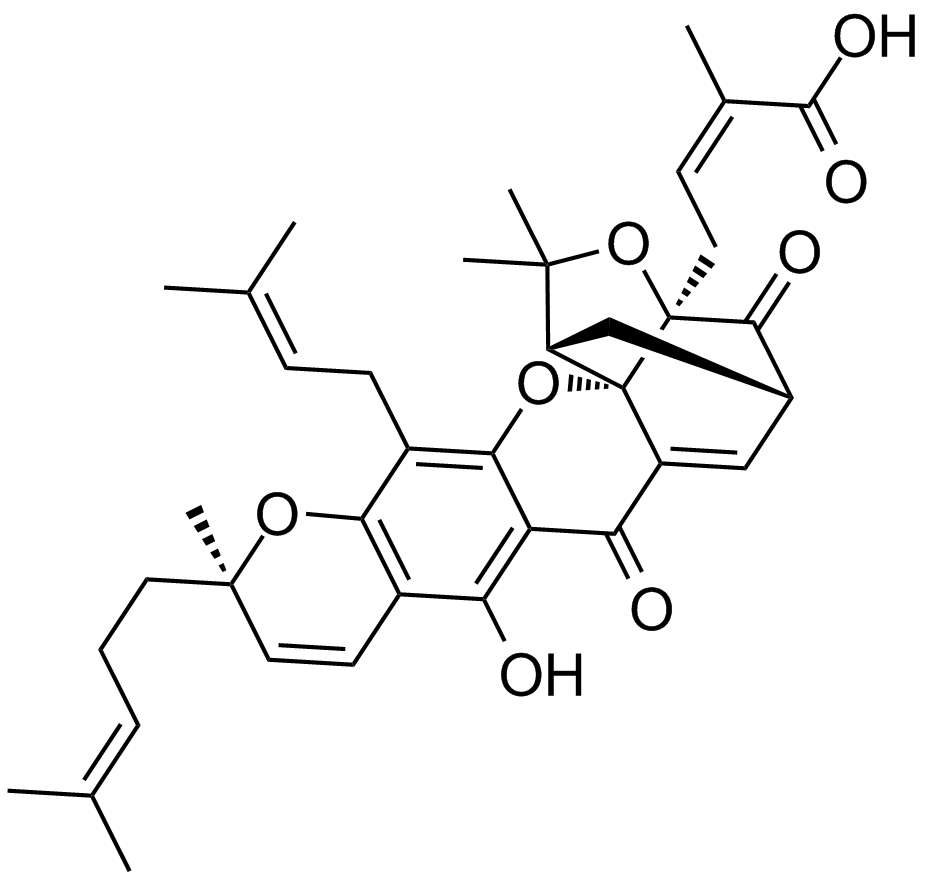Gambogic Acid (Synonyms: GA, β-Guttiferin) |
| Catalog No.GC12139 |
A xanthonoid with anticancer activity
Products are for research use only. Not for human use. We do not sell to patients.

Cas No.: 2752-65-0
Sample solution is provided at 25 µL, 10mM.
Gambogic acid (GA) is an inducer of apoptosis with EC50 value of 0.78-1.64 μM for caspases and with IC50 values of 1.47, 1.21, 2.02, 0.66, 1.06 and 0.79 μM for Bcl-XL, Bcl-2, Bcl-W, Bcl-B, Bfl-1 and Mcl-1, respectively [1].
The cytotoxic natural product GA competes for BH3 peptide binding sites on several antiapoptotic members of the Bcl-2 family and neutralizes the ability of these proteins to suppress release of apoptogenic proteins from mitochondria.
In vitro, it was demonstrated that GA inhibited the proliferation of human gastric carcinoma MGC-803 cells in a dose-dependent manner. When the cells were exposed to GA 5 mg/ml for 72 h, the rate of inhibition reached 89.45%. The IC50 value was 0.96 mg/ml at 48 h. In addition, GA can’t induce cell death in normal unimmortalized cells, but it can selectively kill the tumor cells. Treatment with GA at concentrations above 0.4 μM led to a significant dose-dependent inhibition of U266 cell growth under normoxia and hypoxia when U266 cells exposed to GA under normoxia and hypoxia for 8 h [2, 3].
Using a prostate cancer xenograft model, s.c. injection daily for 15 days was reported that GA effectively inhibited tumor angiogenesis and suppressed tumor growth with few side effects. And using a mouse model of glioma, i.v. injection of GA daily for 14 days was reported to significantly reduce tumor volumes with little side effects. The effects of GA on expression of HIF-1a and its downstream target gene vascular endothelial growth factor was investigated in human MM U266 cells. Tumor xenografts transplanted by U266 cells were used to test the antitumor effect of GA in BALB ?c nude mice in vivo. After a treatment of 14-day, the tumors were moved and photographed. The results indicated that GA significantly inhibited tumor growth in a dosage-dependent manner. After exposure of MGC-803 cells to GA (1 μg/ml) for 24, 48, and 72 h, the apoptosis rate was 38.56, 73.70, and 71.77%, respectively. A number of MGC-803 cells turned round in shape and necrosed, while the untreated cells grew well and the skeleton was clear after cultured with GA 1mg/ml for 48 h [1, 3].
References:
[1]. Zhai DY, Jin CF, Shiau CW, et al. Gambogic acid is an antagonist of antiapoptotic Bcl-2 family proteins. Molecular Cancer Therapeutics, 2008, 7(6): 329-340.
[2]. Zhao L, Guo QL, You QD, et al. Gambogic acid induces apoptosis and regulates expressions of Bax and Bcl-2 protein in human gastric carcinoma MGC-803 cells. Biological & Pharmaceutical Bulletin, 2004, 27(7): 998-1003.
[3]. Wang F, Zhang W, Guo LT, et al. Gambogic acid suppresses hypoxia-induced hypoxia-inducible factor-1/vascular endothelial growth factor expression via inhibiting phosphatidylinositol 3-kinase/Akt/mammalian target protein of rapamycin pathway in multiple myeloma cells. Cancer Science, 2014, 105(8): 1063-1070.
Average Rating: 5 (Based on Reviews and 30 reference(s) in Google Scholar.)
GLPBIO products are for RESEARCH USE ONLY. Please make sure your review or question is research based.
Required fields are marked with *




















